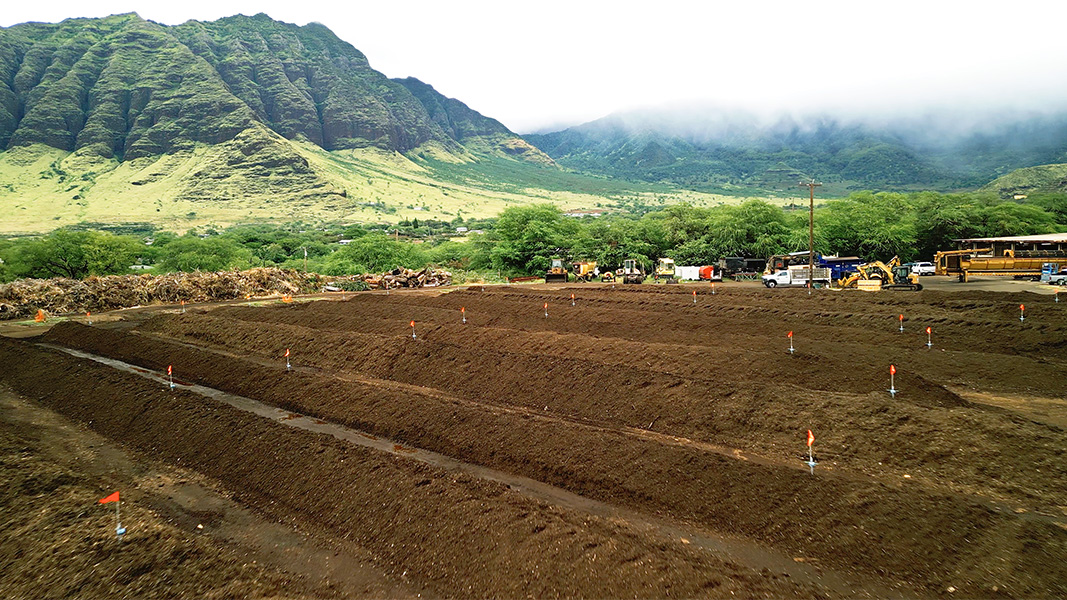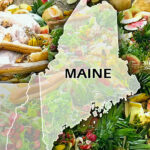Top: Windrow temperature probes (with orange flags) at the Island Topsoil composting site in Waianae, Hawaii transmit readings every 10 minutes. Photos courtesy of Island Topsoil
Island Topsoil in Waianae, Hawaii on the Island of Oahu began in 1990 as a soil screening and blending business. David Souza and his father started the company, building upon a family history of recycling organic waste. “My grandfather operated a dairy on the west coast of Oahu in Waimea,” explains Souza. “He started a business called Family Topsoil, which dried manure from the dairy farm and used it to make different blends for growing crops. At the time, the Dole pineapple company was a large customer. When we first opened Island Topsoil we primarily focused on refining soil into different mixes, e.g., a ‘cinder soil’ for drainage. Over time, we began making soil blends and mixes for a variety of projects. In some cases, we would purchase compost to blend in.”
Around 2012, the Souzas decided to do their own composting, starting with one windrow of green waste turned with a front-end loader. Since then, Island Topsoil’s composting operation has grown significantly, accepting green waste from landscapers, tree trimmers, land clearing companies and other sources. It invested in a horizontal grinder, windrow turner and several screens. “We also accept source separated produce from retail stores, some poultry litter, and will be expanding into a wider range of food waste feedstocks and purchasing depackaging equipment,” says Souza. “Our site has 15 acres of windrows and we take in about 65,000 tons/year of material to compost. The active composting phase is around 2.5 months, followed by curing for a month.”
Process monitoring is very important to Island Topsoil, tracking each windrow throughout active composting and curing. Until this year, a laborer would go out every morning and record the temperatures in each row. “Each day, it would take 2 to 2.5 hours to complete the manual monitoring, plus another 45 minutes to an hour for the clerk to enter the data into a spreadsheet,” he adds. Looking for a more efficient way to collect the data to optimize process control, Souza connected with Reotemp, which had introduced the Reotemp CompostWatch Cloud system in 2022. The temperature probes are placed in the windrows, which are equipped to transmit data within a 1.5 miles line of site. The probe records pile temperatures and transmits the readings every 10 minutes; the data is downloaded into Island Topsoil’s facility data management software.
Souza and others at the facility can view current temperatures in all the windrows and are notified when a windrow meets required PFRP (process to further reduce pathogens) and VAR (vector attraction reduction) parameters. “The software generates compliance reports we need to submit to the state,” he says. “It also feeds into our overall operations management software that we use to record finished compost testing data, destinations for batches of compost, and more. And importantly, installing this system has freed employees up to do other necessary work. When we pencil out this investment, the system will pay for itself.”
A current challenge is an invasive insect, the Rhinoceros beetle, which originated in Guam. The beetles have been laying larvae in the compost curing piles. Island Topsoil distributes its compost to all the Hawaiian Islands via open sea containers. Because of the Rhinoceros beetles, the Hawaii Department of Agriculture has asked the company to not cure the compost to avoid spread of the larvae. “Other companies are fumigating their products in the containers, but we won’t fumigate because it will kill off the beneficial bacteria and fungi in the compost,” explains Souza. “Our current approach is to bring the temperature of the compost up to 131°F and then load the containers and cover them. When the material arrives at its destination, we tell our customers to cure it and then store the compost in a cool shaded area prior to using it.”















